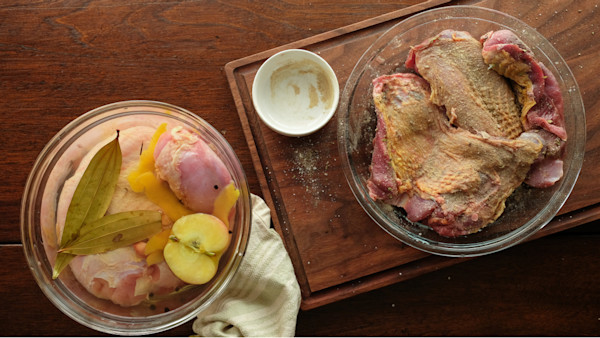
I get asked all the time, “Do I really need to pluck my birds? It’s a pain in the ass!” I hear ya—after a long day in the field, plucking birds isn’t always enjoyable. But after establishing a Thanksgiving tradition of having beautifully plucked whole pheasants roasted with herbs and butter, I had to find an easy way to take the feathers off without ripping up the delicate skin. The answer? Scalding hot water.
Wet plucking, using water to remove feathers, is the method that most commercial and home chicken farmers use when processing their birds. The birds are briefly submerged in a large pot of hot water—it takes very little time, and the feathers come off with little to no effort, resulting in a pretty presentation.
Before you start dunking birds in water, the first thing you should do is make sure you have a bird worth plucking. I think we’ve all been through the necessary evil of letting a puppy retrieve their first bird only to have the meat mangled up. Or perhaps you should have let that bird fly a little further before you pulled the trigger, and the bird is really shot up. In these cases, I honestly don’t bother to pluck them. The skin will be torn, and those holes likely punctured the intestines. The birds are scalded whole (head, crop, and innards still intact), and you don’t want intestinal fluid going into the water bath and cross-contaminating the meat.
Secondly, I prefer to use the wet plucking technique on upland birds such as pheasants, turkey, grouse, and partridge. I don’t like using it on waterfowl because it’s not as effective. Their feathers repel water, making it tricky to get underneath the skin. I’ve always taken the time to dry pluck ducks and geese instead.
I’ve also found that it’s best to wet-pluck birds the same day that they were shot. I used to think it was better to wait a few days when I had a handful of birds to clean all at once, leaving them hanging in a cold garage or a refrigerator until I was ready. However, it tightens the skin, making it take longer for the feathers to come loose. You’ll run the risk of accidentally cooking the meat if you scald it for too long.
Fill the pot with water and heat to 150°F. Grab the bird by its feet and dip it into the water headfirst until it's fully submerged. Nothing but those dinosaur talons should be sticking out. As soon as you put it in the water, start a timer. Turkeys need about 70-90 seconds, medium-sized birds such as pheasants need about 50 seconds, and only 30 seconds for smaller birds like partridge. Keep the bird under the water and vigorously swirl it around to make sure the whole thing—including the spaces between the thighs, breasts, and wings—makes contact with the water. I find that it helps to grab a stick and run it along the sides of the bird to make sure it gets full contact. When the timer goes off, pull it out and let the water drip back into the pot.
As soon as the bird is cool enough to handle, hold it over a trash bag and gently pull off the feathers. You’ll be amazed at how they slip right off! If the feathers don’t come off easily, it could be that the feathers blocked the water from penetrating the skin, or the bird might have been really cold, which easily happens if you’re hunting in the winter. Swirl it around in the water again for another 10-15 seconds, then try again.
After scalding and removing the feathers, you’ll finish processing as usual by removing the head, crop, and innards. Then, rinse clean with cold water. Pat it dry and store it in the refrigerator or freezer until you’re ready to cook.
Scalding birds in hot water is one of the easiest ways to remove their feathers. Not only will you have a beautiful presentation for the table, but the skin keeps the meat juicy when cooking and adds tons of flavor—especially when roasted to a golden crisp!
Related




Hunting with Dogs
The Dog Training Strategy that Will Help You Kill More Public Land Birds This Fall



Conversation